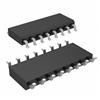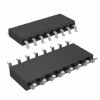Features: The MC33291 is an eight output low side power switch with 8bit serial input control. The MC33291 is a versatile circuit designed for automotive applications, but is well suited for other environments. The MC33291 incorporates SMARTMOSE technology, with CMOS logic, bipolar/MOS analog circuitry, and DMOS power MOSFETs. The MC33291 interfaces directly with a microcontroller to control various inductive or incandescent loads. The circuit's innovative monitoring and protection features are: very low standby current, SPI cascadable fault reporting, internal 53 V clamp on each output, output specific diagnostics, and independent shutdown of outputs. The device is parametrically specified over an ambient temperature range of 40 3 TA 3 125 and 9.0 V 3 VPWR 3 16 V supply. The economical SO24 wide body surface mount plastic packages make the MC33291 a very cost effective solution for many applications.
• Designed to Operate Over Wide Supply Voltages of 5.5 to 26.5 V
• Interfaces Directly with Microprocessor Using 8Bit SPI I/O Protocol to 3.0 MHz
• 1.0 A Peak Current Outputs with Maximum RDS(on) of 1.2 W at TJ = 150
• Outputs Current Limited to 1.0 to 3.0 A for Switching Incandescent Loads
• Output Voltages Clamped to 53 V During Inductive Switching
• Maximum Sleep Current (IPWR) of 25 mA withReset Low
• Maximum of 4.0 mA IDD During Operation
• Maximum of 2.0 mA IPWR During Operation with All Outputs ON
• Open Load Detection (Outputs OFF)
• Overvoltage Detection and Shutdown
• Outputs have Independent Over Temperature Detection and Shutdown
• Output Mode Programmable for Sustained Current Limit or Shutdown
• Independent Output Short Circuit Detect and LatchOff for Every Write Cycle
• Designed for 40 to 125 Ambient Temperature Operation
Specifications
| Rating |
Symbol |
Value |
Unit |
Power Supply Voltage
SteadyState
Transient Conditions (Note 1) |
VPWR(sus)
VPWR(pk) |
1.5 to 26.5
13 to 60 |
V
V |
| Logic Supply Voltage (Note 2) |
VDD |
0.3 to 7.0 |
V |
| Input Pin Voltage (Note 3) |
VIN |
0.3 to 7.0 |
V |
Output Clamp Voltage (Note 4)
(5.0 mA Iout 0.5 A) |
VOUT(off) |
45 to 65 |
V |
| Output Self Limit Current |
IOUT(lim) |
1.0 to 3.0 |
A |
| Continuous Per Output Current (Note 5) |
IOUT(cont) |
500 |
mA
|
ESD Voltage (Note 6)
Human Body Model (Note 7)
Machine Model (Note 8) |
VESD1
VESD2 |
2000
200 |
V
V |
| Output Clamp Energy (Note 9) |
Eclamp |
50 |
mJ |
| Recommended Frequency of SPI Operation |
fSPI |
3.0 |
MHz |
| Storage Temperature |
Tstg |
55 to 150 |
|
| Operating Case Temperature |
TC |
40 to 125 |
|
| Operating Junction Temperature |
TJ |
40 to 150 |
|
| Power Dissipation (TA = 25) (Note 10) |
PD |
2.0 |
W |
| Lead Soldering Temperature (Note 13) |
Tsolder |
260 |
|
Thermal Resistance (JunctiontoAmbient)
SO24 Package
All Outputs ON (Note 11)
Single Output ON (Note 12) |
RJA |
45 |
/W |
NOTES: 1. Transient capability with external 100 W resistor connected in series with VPWR pin and supply.
2. Exceeding these limits may cause a malfunction or permanent damage to the device.
3. Exceeding these limits on SCLK, SI, CSB, SFPD, orReset pins may cause permanent damage to the device.
4. With output OFF.
5. Continuous output rating so long as maximum junction temperature is not exceeded. Operation at 125 ambient temperature will require maximum output current computation using package RqJA.
6. ESD data available upon request.
7. ESD1 testing is performed in accordance with the Human Body Model (CZap = 100 pF, RZap = 1500 ).
8. ESD2 testing is performed in accordance with the Machine Model (CZap = 100 pF, RZap = 0).
9. Maximum ouput clamp energy capability at 150 junction temperature using single nonrepetitive pulse method.
10. Maximum power dissipation at indicated junction temperature with no heat sink used.
11. Thermal resistance from JunctiontoAmbient with all outputs ON and dissipating equal power.
12. Thermal resistance from JunctiontoAmbient with a single output ON.
13. Lead soldering temperature limit is for 10 seconds maximum duration; contact Motorola Sales Office for device immersion soldering time/temperature limits.
DescriptionMC33291 1.2 Ohm Rdson Smart Eight Output Switch with SPI

 MC33291 Data Sheet
MC33291 Data Sheet







